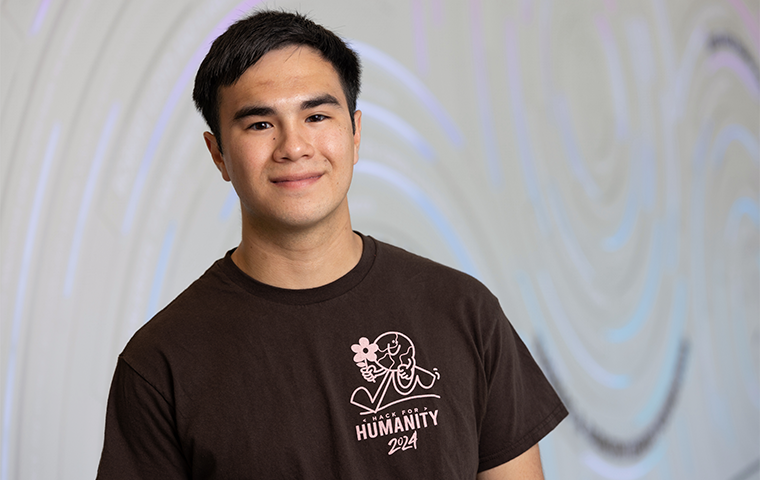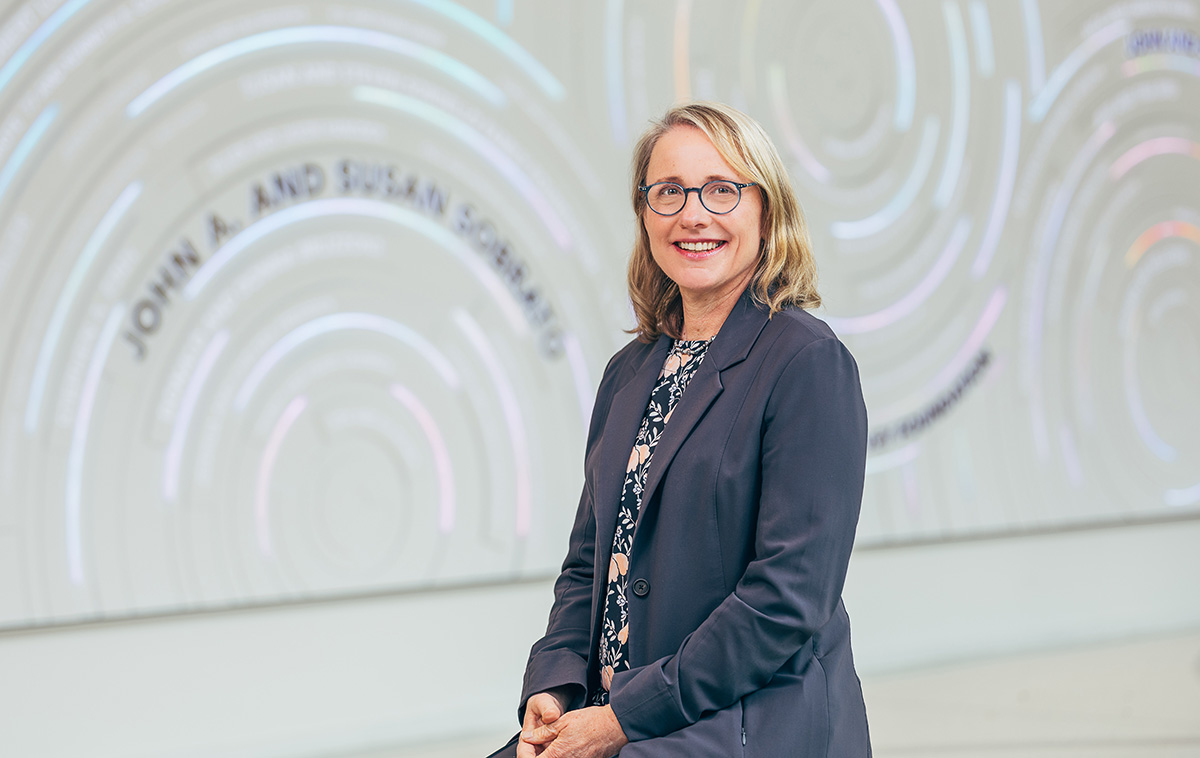Jordan Mosakowski ’24 Cracks the Code To a Meaningful Life

There are 43 quintillion possible configurations that will solve a Rubik’s Cube—but only one answer. Computer science and engineering major Jordan Mosakowski ’24 has cracked the code in just 6.52 seconds.
The world record is 3.13 seconds.
Not bad for a math and computer whiz who got ahold of a standard 3x3x3 Rubik’s Cube at age 10, promptly went online to study solutions, then memorized the algorithms to beat the odds in “cubing” competitions he participates in to this day. (See video below).
“There’s definitely some luck involved,” he says about his impressive times. The trick, according to Mosakowski, is to build up the cube in layers.
“Instead of thinking of it as six individual faces, think of it as three individual layers. There’s still a few moves you need to memorize, but it isn’t as bad as most people would assume.”
Mosakowski moves fast, and not just in cubing contests. When he graduates in June, he’ll have done so in three years, thanks to extra classes he took along the way, and high school AP equivalents that satisfied some requirements at Santa Clara.
He’s already landed a job, too—at Palantir Technologies, where he’ll be working on a team that supports the firm’s cloud infrastructure. All that will wait, however, until he returns from a post-grad trip to Europe, where the Formula One racing fan will attend his very first F1 event, the Austrian Grand Prix. In July, he'll catch the Tomorrowland electronic dance music festival in Belgium.
Speed isn’t the only thing that makes Mosakowski tick. Over the years, he’s used his problem-solving and leadership skills for good, whether designing an app to help high school students keep track of their class schedules, or trying to create a more inclusive environment at SCU’s Association of Computer Machinery club, where he served as president over the last year.
We talked with the Bay Area-born, Colorado-raised dynamo about his passion for computer engineering, lessons he learned at SCU, and how he believes his four years at Santa Clara will help shape his goals in life.
You attribute the Rubik’s Cube to sparking your interest in computer engineering. How so?
Growing up, I was pretty good at math and science, but the way I got into computer science and engineering was through Rubik's Cubes. In fifth grade, I started learning how to solve it, because a friend had learned how to do it, and then through middle school and most of high school, that was the thing I did. I would practice, and then go to competitions once a month.
When I was competing at the CubingUSA Nationals in 2019, there was a guest speaker who was a software engineer, and he talked about why computer science is cool, and how you can relate it to Rubik’s Cubes. And I was like, “Oh, this is super, super, cool. I'm gonna make this my thing now.” And that was kind of how I found computer science as the subject I wanted to learn about in college and beyond.
What’s the connection between a Rubik’s Cube and computer science?
Both are about problem-solving and pattern recognition. With a Rubik's Cube, you have to recognize the physical patterns on a cube to solve it. But with software, it's seeing patterns mainly when it comes to problems. If I see a problem that’s similar to a different problem I had when I was working on software last week, I know I can use that solution to get most of the way there.
What do you hope to accomplish with your computer science and engineering degree?
For me, it comes down to finding things that people struggle with, or need help with, and then building some sort of technical solution to fix that problem.
For example, my high school was constantly changing our bell schedule for when classes started and ended. From my freshman year through my sophomore year, I think it changed three times, which is crazy because nobody could keep track of what the schedule was—different days had different schedules, and it was just super, super confusing.
And I was like, “OK. Here’s what I can do. I can just make an app that people can download on their phones, and it always has the updated schedule for the day. People could just click on it and see exactly what time all of their classes end and start.”
I worked on it over the break and published it on the app store. When we got back from the break, I told my friends and teachers about it and the app just took off. By the end of the first week, it had 1,000 downloads, which was pretty good, considering the school has 1,600 kids. Even today, it's still used by 700 or 800 kids a day
And that's kind of the attitude with all of the software projects that I take on: Is this going to help other people, or myself, do something better? Can it make a direct impact?
For example, last year at Santa Clara I developed a website that lets students at Santa Clara search for classes and view them in a weekly calendar view. I also added many other features that I thought my friends and I would find useful, such as searching classes by professor, name, and core requirements.
The site, called SCU Schedule Planner (scuschedule.com), has been live for about a year now, and has over 1,300 users, so I’m glad I was able to make an impact and save people time when planning their schedules.
At the Senior Design Conference, you and Conner Yin ’24 presented an app to help new employees connect with workplace colleagues who share similar interests. What inspired that idea?
The inspiration came from our internships this past summer. We felt like it was hard to connect with other people at the company—outside of our direct teams—who might share common interests with us. There wasn’t really a support structure to facilitate that connection. So we created an app where you can fill out some of your interests, and anything that might help bridge a connection. It automatically recommends people you might have common interests with, as well as groups, so that you don't have to go out and actively seek that information.
There’s just a lot less time to create connections with other people, especially as more people are working remotely, or only going into the office a few days a week. We think this is going to be a really great way to help people make more connections.

I’ve come to realize that there are a lot of situations that may seem very black and white at first, but it turns out there’s a lot more than meets the eye.
During a summer internship at Amazon in Seattle, you worked with a new technology that allows customers to pay at a store, enter a venue, or badge into work using only their palm. What about that experience stood out to you?
This was the first time I'd worked at a company that was specifically rolling things out to a large number of customers while I was an intern. At Lockheed Martin, I was developing projects for internal use, or for demonstrations to executives, or to visitors. We weren’t really working on things that needed to be running all the time, every day, every second.
At Amazon, I was working on the infrastructure that supports the palm-identity product, called Amazon One. So, for example, when a user signs up, what needs to happen? If we need to send them an email, how does that happen?
I was also learning a lot about what goes on in the background. For example, having an engineer who is always available to help fix a project if it goes down. Or setting up an alarm so that the engineer can be notified when there is a problem. That was something that I'd never done in any of my previous internships, or in any personal projects.
This Amazon technology is groundbreaking and improves the user experience in many ways, but with it comes some ethical concerns. Do you worry about consumer privacy and data security related to biometrics?
It is definitely a little concerning to me, just how much data Amazon and other companies have. But what made me satisfied with the way Amazon One works is that they aren't actually storing your palmprint. It converts a picture of your palm signature into a code that's a string of text. And that string cannot be decoded back into a palm because the algorithm that they've designed only goes one way. So knowing that it's not storing that specific data feels good to me.
What kinds of Jesuit values resonate with you the most?
I’ve come to realize that there are a lot of situations that may seem very black and white at first, but it turns out there’s a lot more than meets the eye.
Trying to understand where people are coming from has been really helpful to me, in terms of ethics, but also when dealing with conflict. In ACM, we often have to make decisions about the future of the club and not everyone agrees. Being able to hear out other people's opinions and understand why they believe a certain way—even though I may disagree with it—has been helpful. If I take the time to understand their logic and reasoning and background, it definitely makes approaching these kinds of conversations a lot easier.
A lot of the Jesuit values apply to another club that I'm involved in, which is Engineers Without Borders. Right now, we’re working with a community in Rwanda to help them build a well to help them access clean water for their community. We've been working with this community for six or seven years now, going across multiple years of students. And now we're at the point where it’s almost done, and we’re wrapping up that project.
What’s one of your favorite things about your Santa Clara experience?
The main draw for me was the smaller classes—they create a really great sense of community. Also, the way the residence halls work, I'm living in a house with five other people right now, and all of us either met through classes or by living in the same dorm, or both. Some of us have known each other since our first quarter at Santa Clara. I think that allowed us to create a really, really tight community of people, especially within the School of Engineering. Even though I didn’t take mechanical engineering classes or electrical engineering classes, I would see these students all the time, either in clubs, or just around. It helped me create a great network of people that I can talk to about pretty much anything.
On top of that, in a more computer engineering/computer science-specific focus, I think what ACM has become is something that’s not rivaled by most other schools’ chapters. I haven’t found any other computer science club that’s doing five meetings a week, and covering so many different topics. I think that that is a very specific draw to people who are interested in computer science. Incoming students would be amazed at the stuff we’re doing—it’s a really great opportunity for them.
The Department of Computer Science and Engineering's broad and integrated curriculum combines the theoretical foundations of computing with the practical engineering knowledge vital to industry.


